Posts Tagged ‘1964’
-
FROM STORIES TO HISTORY
For hundreds of years, the recording of the past focused on public records, statistical data and the lives of prominent people. Yet in recent decades, the spotlight turned onto the general public and its memories in order to provide a more accurate picture of the historic narrative.
 “People who have lived through particular events can contribute different viewpoints and perspectives that fill in the gaps of documented history, at times correcting or even contradicting the written record. The project MEMORJA aims to give a voice to those who have been unheard,” explained James Baldacchino, the administrator of the MEMORJA Project.
“People who have lived through particular events can contribute different viewpoints and perspectives that fill in the gaps of documented history, at times correcting or even contradicting the written record. The project MEMORJA aims to give a voice to those who have been unheard,” explained James Baldacchino, the administrator of the MEMORJA Project.MEMORJA is an oral, sound and visual archive. Its main objective is to employ cutting edge research, methodologies, theoretical and archival approaches and techniques to collect, record, transcribe, preserve and make available and retrievable all the deposited material detailing the islands’ history.
“Work on this project has begun in January 2017. This is a new platform which is giving an additional dimension to the National Archives since this time, it is not only collecting records but reaching out to create them.”
At the early stages of the project, four themes were selected, namely the Second World War, British expatriates in Malta, public administration and the Lampedusa-Malta connection.
 “The theme related to experiences during the Second World War aims to document and record a past which is slowly disappearing from public memory especially with the passing away of the older generation. Oral testimonies and photographs serve to recollect the terrible years of war and what the people have lived through in those times. Stories of the outbreak of hostilities and the first bombings on June 11, 1940, the mass evacuations and refugee experiences, fear and uncertainty, hunger and the Victory Kitchens, shelters and sanitation, soldiers and sirens, and tragedies of bombings are part of the significant remembrance which needs to be collected and preserved for future generations before it is lost for good.”
“The theme related to experiences during the Second World War aims to document and record a past which is slowly disappearing from public memory especially with the passing away of the older generation. Oral testimonies and photographs serve to recollect the terrible years of war and what the people have lived through in those times. Stories of the outbreak of hostilities and the first bombings on June 11, 1940, the mass evacuations and refugee experiences, fear and uncertainty, hunger and the Victory Kitchens, shelters and sanitation, soldiers and sirens, and tragedies of bombings are part of the significant remembrance which needs to be collected and preserved for future generations before it is lost for good.”The history of the relationship between the UK and Malta is another central theme which has not been documented through the eyes of the British and Maltese individuals.
 “This section includes interviews with British and British-Maltese people who were either in the British forces during the 1960’s (or their spouses) and remained in Malta, or civilians who married a Maltese person and relocated to Malta. Such recordings open a window on everyday life in Malta during the 1950s – 1970s. Much of the narratives relate to military bases, post-war experiences, political issues, relationships and cultural differences. This theme was further expanded when the experience of service families’ children was included as well. These children had attended the Naval Childrens’ School and HM Dockyard Children’s School which had occupied sites at Ta’ Xbiex, Cottonera, Senglea and the Dockyard before moving to Tal-Ħandaq.”
“This section includes interviews with British and British-Maltese people who were either in the British forces during the 1960’s (or their spouses) and remained in Malta, or civilians who married a Maltese person and relocated to Malta. Such recordings open a window on everyday life in Malta during the 1950s – 1970s. Much of the narratives relate to military bases, post-war experiences, political issues, relationships and cultural differences. This theme was further expanded when the experience of service families’ children was included as well. These children had attended the Naval Childrens’ School and HM Dockyard Children’s School which had occupied sites at Ta’ Xbiex, Cottonera, Senglea and the Dockyard before moving to Tal-Ħandaq.”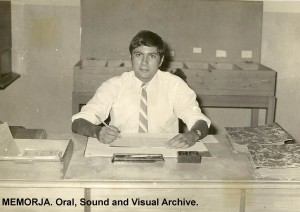 Civil servants are often regarded as those who are implementing the Goverment’s policies. However, through their memories we can get a glimpse of what happenned ‘behind the scenes’ during the most important political, social and economic decisions undertaken by Maltese political leaders.
Civil servants are often regarded as those who are implementing the Goverment’s policies. However, through their memories we can get a glimpse of what happenned ‘behind the scenes’ during the most important political, social and economic decisions undertaken by Maltese political leaders.“These include background revelations of what was taking place during the granting of Independence in 1964, the dismantling of the British military base in 1979 and how the Maltese prepared for such an event, membership in the EU and how it affected the civil service, the migration of the hospital from St Lukes to Mater Dei and many other memorable challenges.”
Lampedusa and Malta are two islands with different political histories. Yet to some extent they share similar economic, trade and socio-cultural interest.
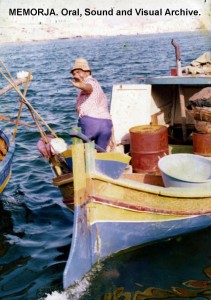 “We have an interest in Lampedusa since in the early 1800s, there were a number of Maltese settlers on this island. Until now, no one had attempted to record these people’s history in order to understand the link between the two islands. The MEMORJA Project is focusing on two time frames to investigate the islands’ shared history. The first one relates to the period from 1800 – 1843 when Lampedusa was colonised by Maltese settlers working in agriculture and animal husbandry. The second covers the period between the 1950s and the 1980s when Lampedusani fishermen visited Malta regularly for the maintenance of ships, the sale of blue fish and the provision of supplies.”
“We have an interest in Lampedusa since in the early 1800s, there were a number of Maltese settlers on this island. Until now, no one had attempted to record these people’s history in order to understand the link between the two islands. The MEMORJA Project is focusing on two time frames to investigate the islands’ shared history. The first one relates to the period from 1800 – 1843 when Lampedusa was colonised by Maltese settlers working in agriculture and animal husbandry. The second covers the period between the 1950s and the 1980s when Lampedusani fishermen visited Malta regularly for the maintenance of ships, the sale of blue fish and the provision of supplies.”As the team of the MEMORJA Project reached out to people, they were soon welcomed by the different communities who were eager to share their recollections.
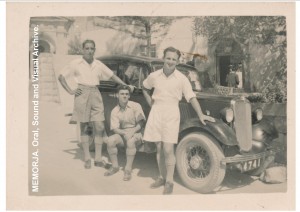 “We found a huge amount of data which existed only in the minds of people and in their photos. Many individuals were enthusiastic to make their voice heard in order to help out with the shaping of the public’s narrative which up to now was not formally recorded for posterity. Even though we have four selected themes, it does not exclude us from recording other memories as well which we deem to be of importance to form part of the community memory.”
“We found a huge amount of data which existed only in the minds of people and in their photos. Many individuals were enthusiastic to make their voice heard in order to help out with the shaping of the public’s narrative which up to now was not formally recorded for posterity. Even though we have four selected themes, it does not exclude us from recording other memories as well which we deem to be of importance to form part of the community memory.”The search for the stories which make the history is still going on. The final goal of the MEMORJA Project which will be officially launched later on this year will be to make this information accessible online for educational and research purposes.
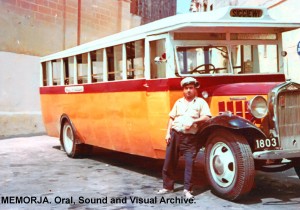 “Oral history allows people to express the personal consequences of change, from the simplest things in life to the more complex. It enables people to share their experiences in their own words, with their own voices, through their own understanding of what happened and why. Eventually, such documentation will offer depth to the understanding of the past to present and future generations.”
“Oral history allows people to express the personal consequences of change, from the simplest things in life to the more complex. It enables people to share their experiences in their own words, with their own voices, through their own understanding of what happened and why. Eventually, such documentation will offer depth to the understanding of the past to present and future generations.”If you are interested to contribute to the MEMORJA Project, you are invited to contact James Baldacchino on james.baldacchino@gov.mt or call 21459863.
The National Archives is located at ‘Santo Spirito’, Hospital Street, Rabat, Malta.
(This article was published in SENIOR TIMES – MAY 2018 issued with The Times of Malta dated 24 May 2018)
-
STUDENTI JGĦINU BIEX TKUN IRKUPRATA L-ISTORJA MITLUFA
“Dawn il-fdalijiet instabu b’kumbinazzjoni fl-1961 meta bdew ix-xogħlijiet għall-bini ta’ din l-iskola. Il-magni goffi użati biex titneħħa l-ħamrija ħalli jinkixef il-blat għas-sisien tal-bini ta’ l-iskola ltaqgħu ma’ knaten kbar tal-ġebel li d-daqs tagħhom kien juri li kien hemm xi bini tal-qedem, probabilment Ruman.”
Hekk bdiet l-istorja tas-sit tal-villa Rumana li tinsab fuq parti mill-art tal-iskola sekondarja Carlo Diacono fiż-Żejtun, infurmana wieħed mid-Diretturi tal-iskavi, Prof. Anthony Bonanno.
Għal dawn l-aħħar ħmistax, l-istudenti tal-Baċellerat tal-Arkeoloġija fl-Università ta’ Malta kienu qed jgħinu fl-iskavi ta’ dan is-sit.
“Wara dawk ix-xhur kollha ta’ teorija, kull student ikun qed jistenna illi jagħmel ftit tal-prattika,” qalilna Dr Nicholas Vella d-Direttur l-ieħor tas-sit arkeoloġiku.
Meta staqsejna lil Prof. Bonanno għala intagħżel proprju dan il-post huwa spjegalna illi “Jeżistu ħafna siti oħrajn li jistħoqqilhom u qed jistennew li jiġu esplorati kif imiss. Iżda dan is-sit sibnieh ideali
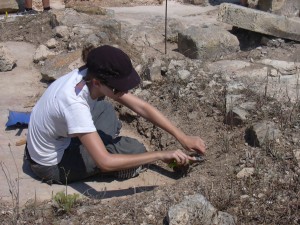 għaliex huwa mħares bil-ħitan ta’ l-iskola. Raġuni oħra hija illi ridna nitfgħu dawl fuq ħafna aspetti ta’ dan il-lok bħal ngħidu aħna l-aspett storiku – iż-żmien li fih inbniet il-villa u kemm damet tintuża, l-aspett soċjali – l-istatus soċjali tas-sidien tal-villa matul iż-żmien u l-aspett teknoloġiku fostom dak relatat ma’ l-għasir taż-żejt tas-sit. Barra minn hekk sibna kooperazzjoni u għajnuna sħiħa kemm mit-tmexxija ta’ l-iskola nnifisha u kif ukoll mill-Kunsill Lokali taż-Żejtun u mis-Suprintendenza għall-Wirt Kulturali.”
għaliex huwa mħares bil-ħitan ta’ l-iskola. Raġuni oħra hija illi ridna nitfgħu dawl fuq ħafna aspetti ta’ dan il-lok bħal ngħidu aħna l-aspett storiku – iż-żmien li fih inbniet il-villa u kemm damet tintuża, l-aspett soċjali – l-istatus soċjali tas-sidien tal-villa matul iż-żmien u l-aspett teknoloġiku fostom dak relatat ma’ l-għasir taż-żejt tas-sit. Barra minn hekk sibna kooperazzjoni u għajnuna sħiħa kemm mit-tmexxija ta’ l-iskola nnifisha u kif ukoll mill-Kunsill Lokali taż-Żejtun u mis-Suprintendenza għall-Wirt Kulturali.”Min-naħa tiegħu Dr Vella qalilna illi x-xogħol li sar din is-sena fuq is-sit kompla jikkonferma kemm dan il-post għandu storja interessanti speċjalment ukoll minħabba li
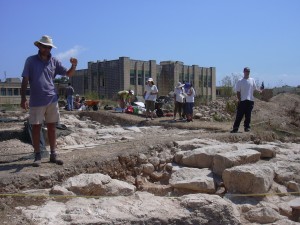 jidher illi għadda minn diversi fażijiet differenti. Fil-fatt jista’ jkun illi dan il-bini jmur lura għal żmien il-Kartaġiniżi jiġifieri fl-età Punika u baqa’ jiġi użat għal ħafna snin wara, sa żmien il-Biżantini. Skont Dr Vella s-sejba ta’ serje ta’ ħitan li nkixfu waqt it-tħaffir probabbilment kienu l-pedamenti ta’ xi sistema ta’ fortifikazzjoni li kien hemm lejn il-baħar, lejn in-naħa ta’ M’Xlokk.
jidher illi għadda minn diversi fażijiet differenti. Fil-fatt jista’ jkun illi dan il-bini jmur lura għal żmien il-Kartaġiniżi jiġifieri fl-età Punika u baqa’ jiġi użat għal ħafna snin wara, sa żmien il-Biżantini. Skont Dr Vella s-sejba ta’ serje ta’ ħitan li nkixfu waqt it-tħaffir probabbilment kienu l-pedamenti ta’ xi sistema ta’ fortifikazzjoni li kien hemm lejn il-baħar, lejn in-naħa ta’ M’Xlokk.“Aktarx min kien jitla’ min-naħa ta’ M’Xlokk kien jara villa imponenti, kważi fortifikata. Sfortunatament illum mill-bini m’għadu jeżisti xejn ħlief il-pedamenti. Imma permezz tat-tfittix tagħna aħna qed nippruvaw immorru lura fiż-żmien ħalli nippruvaw nifhmu l-post.”
“Għall-ewwel il-fdalijiet kienu tqiesu bħala ‘ftit wisq’ biex jibda tħaffir arkeoloġiku fuqhom. Madanakollu fl-1964, waqt li x-xogħol fuq l-iskola kien għadu għaddej, tfaċċaw aktar fdalijiet. Fil-fatt taħt il-ħarsien ta’ l-awtoritajiet tal-Mużew instabu ġiebja kbira, ringiela ta’ kanali ta’ l-ilma u kamra bil-madum. Sfortunatament ma sar xejn iktar sal-1971 meta beda t-tiftix bis-sehem ta’ studenti barranin taħt is-superviżjoni tal-Kuratur ta’ l-Arkeoloġija, Tancred Gouder.”
Prof. Bonanno kompla jgħidilna kif fl-1976 u l-1977 huwa mexxa skav żgħir fuq xi trinek li kien fassal Tancred Gouder. Iżda s-sit kellu jistenna 20 sena oħra qabel ma reġa’ beda l-iskav li qed isir mill-2006 ’l hawn mid-Dipartiment ta’ l-Arkeologija ta’ l-Università ta’ Malta. Barra minn hekk, permezz ta’ dan ix-xogħol qed isir attentat biex tiġi rkuprata l-informazzjoni li ntilfet mill-1970 ‘l hawn.
“Jien, min-naħa tiegħi, żammejt noti tal-ġimgħatejn tiftix li kont mexxejt. Iżda s’issa għadna ma sibna l-ebda notamenti ta’ l-iskavi tas-snin 60 u 70 ħlief pjanta magħmula minn Frans Mallia fl-1971 u l-ftit
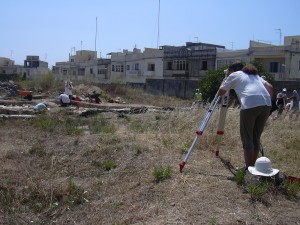 informazzjoni ppubblikata fil-Museum Annual Reports. Għalhekk, per eżempju, għadna qed nitħabtu biex nikxfu fejn tinsab il-ġiebja l-kbira li nstabet fl-1964. Ta’ min jgħid iżda li l-fdalijiet ta’ fuħħar u oġġetti oħra li ħarġu mit-tiftix ta’ Tancred Gouder kollu għadu maħżun fil-kaxxi (bil-marki ta’ minn fejn ġew) fil-Palazz ta’ Vilhena fl-Imdina. Dan il-materjal kollu qiegħed jiġi studjat,” ikkonferma Prof. Bonanno.
informazzjoni ppubblikata fil-Museum Annual Reports. Għalhekk, per eżempju, għadna qed nitħabtu biex nikxfu fejn tinsab il-ġiebja l-kbira li nstabet fl-1964. Ta’ min jgħid iżda li l-fdalijiet ta’ fuħħar u oġġetti oħra li ħarġu mit-tiftix ta’ Tancred Gouder kollu għadu maħżun fil-kaxxi (bil-marki ta’ minn fejn ġew) fil-Palazz ta’ Vilhena fl-Imdina. Dan il-materjal kollu qiegħed jiġi studjat,” ikkonferma Prof. Bonanno.Xtaqna nkunu nafu jekk ħmistax il-ġurnata humiex biżżejjed biex tilħaq tagħmel riċerka adegwata…
“Ħmistax ifissru fir-realtà għaxart ijiem, li minnhom tneħħi jumejn moħlija biex tinkixef l-għata protettiva li nkunu poġġejna s-sena ta’ qabel u biex fl-aħħar tal-ħidma
 tagħna nerġgħu ngħattu. Madankollu sar ħafna xogħol siewi billi inżilna mhux ħażin fil-ġiebja (jew bir) li sibna. Kxifna għal kollox ġebla ċatta kbira u lixxa li rriżulta li kienet il-qiegħ ta’ ħawt kbir rettangolari li fih kien jinġemgħa ż-żejt magħsur taż-żebbuġa. Fuq din tidher evidenti fażi oħra iktar tard fiż-żmien, ta’ attività strutturali, aktarx agrikola. F’dawn il-ħmistax saret ukoll ħafna dokumentazzjoni li ma setgħetx tistenna sas-sena d-dieħla.”
tagħna nerġgħu ngħattu. Madankollu sar ħafna xogħol siewi billi inżilna mhux ħażin fil-ġiebja (jew bir) li sibna. Kxifna għal kollox ġebla ċatta kbira u lixxa li rriżulta li kienet il-qiegħ ta’ ħawt kbir rettangolari li fih kien jinġemgħa ż-żejt magħsur taż-żebbuġa. Fuq din tidher evidenti fażi oħra iktar tard fiż-żmien, ta’ attività strutturali, aktarx agrikola. F’dawn il-ħmistax saret ukoll ħafna dokumentazzjoni li ma setgħetx tistenna sas-sena d-dieħla.”Xorta waħda ż-żewġ diretturi saħqu illi mis-sena d-dieħla qed jisperaw illi jżidu ż-żmien tal-iskavar għal erbgħa ġimgħat. L-iskop ewlieni ta’ l-iskavi huwa biex jitħarrġu arkeologi ġodda fil-metodi xjentifiċi tat-tiftix arkeoloġiku u biex jitkattar l-għerf dwar l-antenati tagħna. Il-ħsieb huwa illi l-iskavi jibqgħu jsiru f’dan il-post sakemm jiġi eżawrit l-iskop tar-riċerka.
“Nixtiequ nikkoperaw ma’ dawk kollha, fostom mal-Kunsill Lokali taż-Żejtun, li jixtiequ jagħmlu minn dan is-sit attrazzjoni edukattiva mhux biss għat-turisti iżda wkoll għall-Maltin. Imma dan jeħtieġ rieda u riżorsi biex dak li nkixef jiġi kkonservat u mħares mill-elementi sabiex ikun jista’ jitgawda minn ta’ dawk li jiġu warajna.”
(Dan l-artiklu ġie ppubblikat fit-Torċa tat-12 ta’ Lulju 2009)
Travelogue
Archives
| M | T | W | T | F | S | S |
|---|---|---|---|---|---|---|
| « Jan | ||||||
| 1 | 2 | 3 | 4 | 5 | 6 | 7 |
| 8 | 9 | 10 | 11 | 12 | 13 | 14 |
| 15 | 16 | 17 | 18 | 19 | 20 | 21 |
| 22 | 23 | 24 | 25 | 26 | 27 | 28 |
| 29 | 30 | |||||
Recent Posts
- A MATTER OF FATE
- MALTA’S PREHISTORIC TREASURES
- THE MAGIC IS IN THE DETAIL
- THE SELLING GAME
- NEVER FORGOTTEN
- Ġrajjiet mhux mitmuma – 35 sena mit-Traġedja tal-Patrol Boat C23
- AN UNEXPECTED VISIT
- THE SISTERS OF THE CRIB
Comments
- Pauline Harkins on Novella – Li kieku stajt!
- admin on IL-KARNIVAL TRAĠIKU TAL-1823
- Albert on IL-KARNIVAL TRAĠIKU TAL-1823
- Martin Ratcliffe on Love in the time of war
- admin on 24 SENA ILU: IT-TRAĠEDJA TAL-PATROL BOAT C23